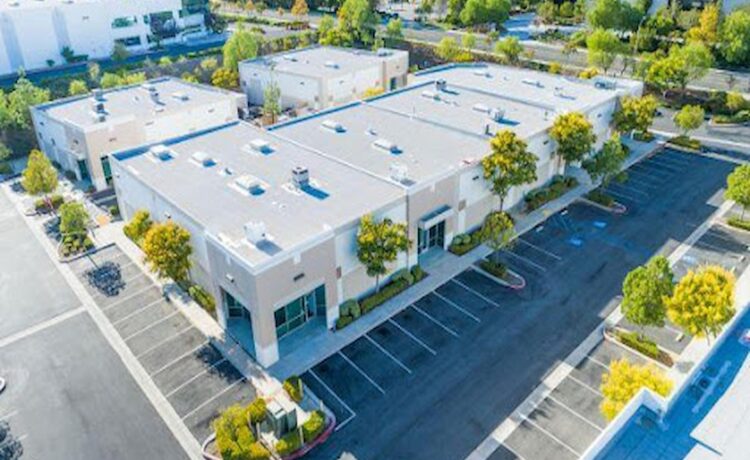There are as many different types of roofs as there are buildings, with most commercial buildings sporting flat roofing systems made from any one of a variety of materials. The roof of a commercial building has an important job to do: it must keep out rain, snow, and cold air while also protecting the interior from the harsh rays of the sun. And while residential buildings are often built with a steep slant to their roofs, commercial flat roofing doesn’t always have an easy way for rainwater to roll off.
Ensuring that your roof always protects your business from the elements is a matter of investing in the best commercial flat roofing system you can. Below, we’ll discuss what you need to look for when it comes to roofing materials and how you can ensure your roof is maintained in such a way that it will keep the elements out for years to come.
Why Are Commercial Roofs Flat?
There are several advantages to the sloped roofs commonly seen on houses all over the world. Mainly, they allow water to run off the roof easily while also allowing for plenty of extra storage space in the attic. Commercial buildings, on the other hand, don’t usually have attics, so this particular form of storage space isn’t required. However, proper water drainage is a must no matter what type of building it is, so why are commercial rooftops flat?
The main reason is the ease of construction. As you can imagine, sloped rooftops take more time and resources to build. This is fine for a house, as houses are meant to be lived in and can sell at greater prices. Businesses, however, need to think more about the practicality of the structures they inhabit. That’s why flat roofs are more popular for commercial buildings.
The other major benefit of flat rooftops for businesses is the placement of HVAC systems. Of course, residential buildings have heating and air conditioning too, but it generally doesn’t need to operate on an industrial scale. By utilizing flat rooftops, large-scale HVAC systems can be installed in the building or on top of it without interfering with any of the ongoing commercial operations of the business.
But Are They Really Flat?
Of course, commercial flat roofing systems can’t truly be entirely flat because then there would be no way for water to drain off of them. If this were the case, water would simply pool on the rooftop gradually eating away at the roof, ultimately getting through it and seeping into the building itself. Water damage, of course, can be catastrophic for any business, potentially destroying thousands of dollars’ worth of equipment and necessitating extremely costly repairs.
For this reason, commercial rooftops are usually built with a very slight slant to them: usually about a 2 percent slope. This is enough to allow water to drain off effectively, but it won’t interfere with HVAC installation, and it will still allow maintenance workers and roofing contractors to walk around on the rooftop easily.
What Materials Are Used in Their Construction?
The material used to make up the roof of a commercial building depends on a number of factors, with the nature of the business itself and the local climate being important considerations.
Metal Roofing is an inexpensive option for buildings that don’t require a great deal of climate protection, such as some industrial structures. The rooftop is made from corrosion-resistant, inexpensive metals such as aluminum and can be layered on in large sheets. If rust does occur, these sheets can be replaced fairly inexpensively.
Single-ply roofing is one of the most popular materials for climates that experience a lot of both sunny and rainy weather, such as in the Pacific Northwest, because it is relatively inexpensive to install and effective. It consists of a sheeted membrane, usually made from an impermeable material such as thermoplastic, that can be rolled out across a low-slope roof. It isn’t in the installation costs where this material really shines, however. Even more impressive is its ability to reflect away solar radiation, saving you money on air conditioning costs during the hot summer months.
Built-Up Roofing, also sometimes called 3-Ply Roofing, is a bit more complex and expensive than single-ply, but excellent for protecting your business from the weather. It begins with a flat cover board made from some type of insulating material, with the rest of the materials being installed on top of that. The “ply” in 3-ply roofing actually refers to sheets of roofing material, which are used for reinforcement. These are held in place and waterproofed using layers of modified bitumen (similar to asphalt), which becomes highly water resistant as it solidifies.
So, Which One Is Actually the Best?
At the end of the day, the best commercial flat roofing system depends on the needs of your business and your budget. Built-up roofing is excellent if your equipment is highly sensitive to climate, while single-ply is great if you are looking for something inexpensive but effective. For maximum efficiency, look for the Energy Star certification, which ensures high energy efficiency and reflectivity in the roofing material.
Ultimately, proper maintenance and care are as important as the actual material your commercial roof is made from. A properly maintained roof can last for many, many years and will constantly work to keep the elements out and keep your energy costs down. Regularly having your roof inspected and any leaks repaired will save you an incredible amount of money in the long run.
Regular maintenance starts with finding the right roofing contractor. Do your research before hiring any company to perform installation or repairs for your commercial roof. Don’t be afraid to talk to other customers and check references. You’ll want companies with proven track records—for example, a commercial flat roofing company like Interstate Roofing, which has had decades of success in the business—and you’ll want to take a look at some of their past work as well.





